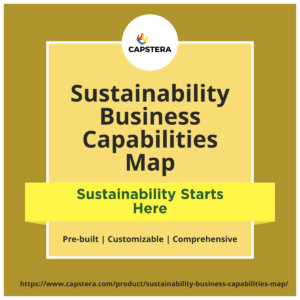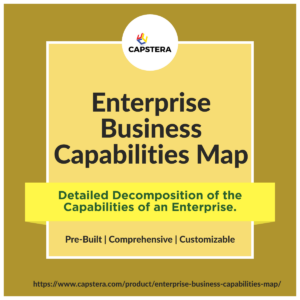
The ultimate guide to leveraging Business Architecture for Sustainability. In today’s global economy, sustainability is more than a buzzword; it’s a vital necessity. With 68% of global consumers willing to pay more for sustainable products (Nielsen, 2015), and a whopping 85% of S&P 500 companies publishing sustainability reports in 2019 (Governance & Accountability Institute), the demand for responsible corporate behavior has never been higher. Climate change, resource depletion, and societal pressures are driving businesses to reevaluate their environmental and social footprints.
Importance of Sustainability in Modern Business
The importance of sustainability in modern business extends beyond environmental stewardship. From a financial perspective, companies embracing sustainability see an average 4.8% higher operational performance than their peers (Oxford University and Arabesque Partners, 2015). Sustainability initiatives are now considered essential in enhancing brand image, customer loyalty, and stakeholder trust. For instance, Unilever’s “Sustainable Living” brands have grown 69% faster than the rest of the business (Unilever, 2018).
Challenges in Implementing Sustainability Initiatives
Despite the apparent benefits, implementing sustainability initiatives is fraught with challenges. The most significant include a lack of clear vision and integration into core business strategies. Other hurdles are inadequate regulatory understanding, the complexity of global supply chains, and inconsistencies in measurement and reporting. For example, Volkswagen faced a significant backlash and loss of trust when it was revealed that they manipulated emission tests in 2015.
Words are Louder than Actions
Regrettably, the sustainability landscape is marred by cases where words are louder than actions. Many corporations announce grand plans but fail to follow through. A 2021 study by NewClimate Institute found that only 20% of companies are aligning their emissions reduction targets with the Paris Agreement’s goals. The gap between promised change and real actions can lead to “greenwashing” accusations, where companies exaggerate their environmental efforts. HSBC, for instance, was accused of greenwashing by investing in fossil fuels while promoting their sustainability commitments.
Leveraging Business Architecture for Sustainability
Business architecture offers a promising solution to these challenges. It provides a structural framework that aligns an organization’s operational functions with its strategic goals. Business architecture can serve as a blueprint, mapping out the path towards meaningful sustainability integration into all facets of a company’s operations. Consider Interface, a global carpet manufacturer, that utilized business architecture principles to transform itself into a zero-emission company. Their framework focused on designing products that could be recycled or reused, rethinking manufacturing processes, and fostering a company-wide culture centered on sustainability.
The integration of sustainability into the very fabric of business is no longer an option but a requirement. While significant challenges and instances of inaction exist, the role of business architecture as a systematic and structured approach can help corporations successfully shepherd their sustainability efforts. By turning promises into concrete actions, businesses can position themselves at the forefront of the global sustainability movement.
Sustainability and ESG Efforts
 Concepts and Components
Concepts and Components
Sustainability refers to the practice of meeting present needs without compromising the ability of future generations to meet theirs. It encompasses three main pillars: environmental protection, social equity, and economic viability. ESG (Environmental, Social, and Governance) efforts focus on a company’s conduct concerning these three aspects. Environmental refers to a company’s impact on nature, Social involves the relationships with employees and communities, and Governance pertains to the company’s leadership and internal practices.
Global Trends and Regulations
The global emphasis on sustainability and ESG compliance is growing, with numerous regulations and guidelines emerging. For example, the European Union has introduced the Sustainable Finance Disclosure Regulation (SFDR) to increase transparency. The UN’s Sustainable Development Goals (SDGs) have also set 17 global targets to be achieved by 2030. Governments around the world are adopting carbon neutrality goals, such as China’s commitment to reaching carbon neutrality by 2060.
Benefits and Importance of Sustainability for Corporate Image
In an age where consumer consciousness about sustainability is rising, a strong commitment to ESG factors can enhance a company’s image. According to a 2020 survey by IBM, 77% of consumers consider sustainability as a crucial factor in their purchasing decisions. Corporations like Tesla have built entire brands around sustainability, leading to increased market share and customer loyalty. Employee satisfaction also tends to be higher in companies that emphasize sustainability, with 40% of millennials choosing a job based on the company’s sustainability practices (Swytch, 2019).
The Disconnect Between Aspirations and Execution
Unfortunately, there often exists a wide gap between sustainability aspirations and execution. This disconnect might arise from a lack of alignment between a company’s sustainability goals and its core business strategy or from inadequate resources and expertise. According to a 2019 survey by BCG, while 92% of executives considered sustainability a priority, only 25% had developed a clear plan for achieving their sustainability goals. The failure to translate intent into action leads to lost opportunities and potential reputational risks.
Case Studies of Successful and Unsuccessful Efforts
- Successful Efforts:
-
- Patagonia: The outdoor apparel company Patagonia has successfully embedded sustainability into its business model. They donate 1% of their total sales to environmental causes and have committed to being carbon neutral by 2025.
- IKEA: IKEA’s commitment to sustainability is exemplified by its goal to become 100% circular and climate-positive by 2030. As part of this, they are increasing the use of renewable and recyclable materials in their products.
- Unsuccessful Efforts:
-
- Boeing: Despite announcing significant sustainability initiatives, Boeing faced criticism for not meeting its environmental goals and struggling with transparency in reporting its progress.
- BP: British Petroleum’s “Beyond Petroleum” campaign ended up as an example of greenwashing. Although they promised to shift focus towards renewable energy, they continued to invest heavily in oil and gas, leading to public mistrust.
Understanding sustainability and ESG efforts is critical in today’s business world. While the benefits are evident, and global trends are moving towards increased regulation and awareness, the execution of sustainability initiatives remains a complex challenge. Examining successful and unsuccessful efforts provides valuable insights into how corporations can bridge the gap between aspirations and reality, fostering a corporate environment that aligns with the global shift towards sustainable practices.
Challenges in Structured Sustainability Implementation
Lack of a Cohesive Strategy
A comprehensive and cohesive sustainability strategy is paramount to successful implementation, yet many companies fall short. Lack of alignment between departments, unclear objectives, and conflicting priorities often hinder progress. For example, General Electric’s failed “Ecomagination” initiative, launched in 2005, faced criticism for its lack of consistency and clarity in objectives, leading to poor results.
Integration with Existing Business Models
Integrating sustainability into existing business models is a complex task requiring complete transformation at various levels. Companies like Ford have faced challenges in shifting towards electric vehicles while maintaining a traditional manufacturing base. This required not just technological advancement but a complete reshaping of supply chain practices, manufacturing processes, and marketing strategies.
Measurement and Tracking Issues
Measuring and tracking sustainability metrics are often fraught with challenges due to the lack of standardized criteria and diverse impacts across industries. PepsiCo faced difficulties in tracking water usage across different geographical locations and manufacturing processes. They had to develop a tailored approach to accurately measure and reduce water consumption. As of 2020, only 29% of companies consistently measure the ROI of their sustainability efforts (MIT Sloan Management Review), highlighting the widespread challenge of effective measurement.
Regulatory Compliance and Reporting
With an increasing array of global and regional regulations concerning sustainability, compliance and reporting have become cumbersome tasks. In 2020, Facebook faced a legal challenge in Europe for failing to comply with GDPR, a regulation that extends to data sustainability and ethical handling. Conflicting regulations across jurisdictions, evolving standards, and the lack of an internal legal understanding can turn compliance into a significant barrier to sustainability initiatives.
Resistance to Change within the Organization
Perhaps one of the most subtle yet potent challenges is resistance to change within the organization. Embedding sustainability into the core of business operations often necessitates a cultural shift. Kodak’s failure to adapt to the digital revolution serves as a poignant example of how resistance to change can lead to a company’s downfall. While not directly related to sustainability, the lesson on organizational flexibility and adaptability is universal. A 2013 survey by McKinsey found that 42% of executives identified employee resistance as a significant barrier to organizational change.
The road to structured sustainability implementation is fraught with challenges. From the absence of a cohesive strategy to the complexities of integration, measurement, regulation, and internal resistance, the obstacles are manifold. Companies aspiring to lead in the sustainability domain must acknowledge these challenges and develop robust strategies to overcome them. By drawing lessons from both failures and successes, businesses can navigate this complex landscape and build a future that aligns profitability with responsibility. The commitment to sustainability must translate into thoughtful planning and relentless execution, with a willingness to learn, adapt, and innovate at every step.
Level Set about Business Architecture
Definition and Key Components
Business architecture represents the blueprint of an organization, outlining its structure, processes, information, and technology. It serves as a vital tool to align an enterprise’s strategy with actionable objectives. Key components include:
- Capabilities: These are the abilities that a business must have to deliver value, such as innovation or customer relationship management.
- Value Streams: These outline the series of steps that deliver value to customers and other stakeholders.
- Information Architecture: This includes the data and information used within a business and how it flows between processes.
- Organizational Structure: This reflects the relationships among various roles and teams within the company.
Relationship to Business Strategy and Execution
Business architecture plays a pivotal role in translating a company’s business strategy into actionable plans. It helps in understanding how different parts of an organization work together, enabling better decision-making, optimizing resources, and ensuring that efforts align with strategic goals. Microsoft, for example, has leveraged business architecture to guide its transformation into a cloud-first company, ensuring alignment across various business units and technological innovations.
Importance of Aligning Business and Sustainability Goals
Aligning business and sustainability goals is not just ethical; it is also a strategic imperative. By integrating sustainability into the core architecture of a business, organizations can create a synergistic effect that enhances both financial performance and social responsibility. Unilever’s Sustainable Living Plan, launched in 2010, represents an integrated approach where sustainability goals are intertwined with business objectives, leading to a 50% reduction in waste and a 40% reduction in greenhouse gas emissions by 2020.
Case Studies of Leveraging Business Architecture for Sustainability Implementation
- Walmart’s Sustainability Journey: Walmart implemented an effective business architecture to reduce waste and promote sustainability across its global supply chain. This included measures like improving fleet efficiency by 87% since 2005 and committing to 100% renewable energy.
- Siemens’ Environmental Portfolio: Siemens has leveraged business architecture to create an Environmental Portfolio, focusing on products and solutions that contribute to environmental protection. This alignment with sustainability goals led to generating €40 billion in revenue in 2019 from their green portfolio.
- Interface’s Mission Zero: Carpet manufacturer Interface redesigned its entire business model through a robust business architecture that aimed at zero environmental impact by 2020. This involved innovative recycling programs, waste reduction initiatives, and a cultural shift towards sustainability across the organization.
Business architecture serves as a comprehensive framework that aligns an organization’s structure, capabilities, and goals. It plays a critical role in bridging the gap between strategic planning and execution and is essential for incorporating sustainability into the very fabric of an organization. By leveraging the principles of business architecture, companies like Walmart, Siemens, and Interface have demonstrated that it is possible to merge business success with environmental and social responsibility. This integration sets a new standard for how businesses can thrive in an increasingly complex and sustainability-conscious world.
Leveraging Business Architecture for Sustainability Efforts
Aligning Sustainability with Elemental Capabilities
 Elemental capabilities refer to the foundational abilities and competencies that a company must possess to achieve its objectives. By aligning sustainability with these capabilities, an organization ensures that sustainable practices become a part of its core functioning. Nestlé, for example, aligned its sustainability efforts with its core capability of innovation. By doing so, they developed environmentally friendly packaging and water-saving technologies, reflecting a commitment to sustainability at the very heart of their business operations.
Elemental capabilities refer to the foundational abilities and competencies that a company must possess to achieve its objectives. By aligning sustainability with these capabilities, an organization ensures that sustainable practices become a part of its core functioning. Nestlé, for example, aligned its sustainability efforts with its core capability of innovation. By doing so, they developed environmentally friendly packaging and water-saving technologies, reflecting a commitment to sustainability at the very heart of their business operations.
Integration of Core Value Streams
Value streams represent the sequences of activities that deliver value to customers and other stakeholders. Integrating sustainability into these value streams means infusing sustainable practices throughout the process of delivering goods and services. Ford has accomplished this by incorporating sustainability into its entire value chain, from materials sourcing to manufacturing and distribution. By 2022, they aim to reduce CO2 emissions per vehicle produced by 30%, integrating environmental stewardship into their core value delivery.
Creation of a Systematic Blueprint for Sustainability
A systematic blueprint for sustainability entails a well-defined plan that encompasses every aspect of an organization’s sustainability agenda. Such a blueprint serves as a roadmap for the integration, measurement, and continuous improvement of sustainability efforts. Toyota’s Environmental Challenge 2050 is an example of a comprehensive plan, aiming for a 90% reduction in CO2 emissions and a commitment to complete lifecycle zero emissions, meticulously aligning every part of their business with these sustainability goals.
Tools and Frameworks for Guiding Efforts
Several tools and frameworks can assist in guiding sustainability efforts within the context of business architecture. The Global Reporting Initiative (GRI) and the Sustainability Accounting Standards Board (SASB) provide guidelines for sustainability reporting. Moreover, the use of technology like Environmental Management Systems (EMS) or Enterprise Resource Planning (ERP) systems, such as SAP’s sustainability suite, enable real-time tracking and management of sustainability metrics.
Collaboration Across Departments and Stakeholders
Sustainability is not the sole responsibility of one department but requires a concerted effort across the entire organization and even beyond. Collaborative efforts must extend to suppliers, customers, regulators, and the broader community. Coca-Cola’s water stewardship program demonstrates this cross-functional collaboration. Working with local communities, governments, and NGOs, they’ve replenished 100% of the water used in their finished beverages as of 2020, showcasing how a collective approach can create significant sustainability impacts.
Leveraging business architecture for sustainability efforts is not only a strategic approach but an essential one in today’s globally connected world. Aligning sustainability with elemental capabilities, integrating it into core value streams, creating a systematic blueprint, employing appropriate tools and frameworks, and fostering collaboration can transform the sustainability agenda from mere buzzwords to actionable, measurable outcomes. Companies like Nestlé, Ford, Toyota, and Coca-Cola illustrate that it is indeed possible to intertwine profitability with responsibility, setting a precedent for future generations of businesses. By adopting these practices, today’s corporations can become torchbearers of a sustainable future, where business success and environmental stewardship coexist and thrive.
Implementation Roadmap
Implementing a sustainable business architecture requires a methodical and tailored approach. This section outlines a roadmap that companies can follow, illustrated with real-life examples and statistics where appropriate.
Assessing Current State of Sustainability Efforts
The initial step involves a comprehensive assessment of the current state of sustainability efforts within the organization. This includes analyzing existing policies, practices, and performance. For example, Procter & Gamble conducted a thorough audit of its water usage across all operations, identifying areas for improvement. This baseline assessment sets the stage for targeted interventions.
Defining Objectives and Key Performance Indicators (KPIs)
Clearly defined objectives and KPIs ensure alignment and focus. Unilever, through its Sustainable Living Plan, set precise targets such as halving the environmental footprint of its products by 2030. Key Performance Indicators included metrics on waste reduction, energy efficiency, and sustainable sourcing. Specific, measurable objectives and KPIs provide a clear direction and allow for precise monitoring.
Designing a Customized Business Architecture Framework
Every organization is unique, and so the business architecture framework for sustainability must be customized to fit the specific needs and context of the business. Johnson & Johnson created a customized framework called Earthwards®, focusing on product stewardship and environmental impact across the product lifecycle. This unique approach reflects the company’s specific industry needs and sustainability objectives.
Roadmap for Execution, Including Phases and Timelines
A detailed execution plan that includes various phases and timelines is critical to successful implementation. IKEA’s sustainability strategy, for instance, is divided into phases targeting different aspects like sustainable sourcing, renewable energy, and waste management, with a final goal of becoming a circular and climate-positive business by 2030. This phased approach allows for focused execution and provides clear milestones.
Ongoing Monitoring, Reporting, and Continuous Improvement
Ongoing monitoring and reporting are essential to ensure that sustainability efforts stay on track and evolve with changing circumstances. Using the Global Reporting Initiative (GRI) standards, Adobe produces an annual sustainability report, tracking progress against its goals, such as reducing water use by 60% by 2025. Continuous improvement, illustrated by companies like 3M with its Pollution Prevention Pays program, has saved them over $2 billion since its inception in 1975, underscoring the importance of iterative learning and adaptation.
Implementing sustainability through a business architecture framework requires a systematic and thoughtful approach. Assessing the current state, defining clear objectives and KPIs, customizing the framework to the unique needs of the business, executing through a phased roadmap, and ensuring ongoing monitoring and continuous improvement can turn lofty sustainability goals into tangible outcomes. By following this structured roadmap, organizations not only contribute to a more sustainable future but also enhance their competitive advantage in an increasingly resource-conscious global market. The successes of companies like Procter & Gamble, Unilever, Johnson & Johnson, IKEA, Adobe, and 3M serve as inspiring examples of what is achievable when intention and action align within a robust strategic framework.
Case Studies and Best Practices Leveraging Business Architecture for Sustainability
Examples of Corporations Successfully Utilizing Business Architecture
- General Electric’s Ecomagination Initiative: GE implemented its Ecomagination strategy to align business goals with sustainability. By incorporating eco-friendly products into its value streams and committing $15 billion to research and development, GE generated over $300 billion in revenues from these products between 2005 and 2020.
- Philips’ Circular Economy Approach: Philips applied business architecture principles to transform into a circular economy model. By 2025, they aim to have 25% of their revenue come from circular products, services, and solutions. Their efforts have already led to a 21% reduction in carbon emissions.
- HSBC’s Sustainable Financing Framework: HSBC leveraged business architecture to develop a sustainable financing framework. By committing $1 trillion towards financing, investment, and advisory support to environmental projects by 2030, HSBC has positioned itself as a leader in sustainable banking.
Lessons Learned and Common Pitfalls to Avoid
- Misalignment of Goals: Dell’s early sustainability efforts faced challenges due to misalignment between business and sustainability goals. A reevaluation and integration of sustainability into its core business architecture helped Dell reduce its packaging by over 20 million pounds since 2008.
- Ignoring Cultural Aspects: Kodak’s failure to adapt to the digital transformation is a lesson in the importance of considering organizational culture in implementing new strategies, including sustainability. Resistance to change can derail even the most well-planned strategies.
- Lack of Collaboration: BP’s Deepwater Horizon disaster in 2010 highlighted the pitfalls of inadequate collaboration and communication among different departments and stakeholders. Comprehensive business architecture would have facilitated better risk management and adherence to sustainability practices.
Practical Insights and Recommendations
- Start with a Clear Vision and Alignment: As demonstrated by Unilever, a clear vision that aligns business and sustainability goals is key to success. Their Sustainable Living Plan has set the path for long-term growth and environmental stewardship.
- Incorporate Flexibility: The rapid shift towards electric vehicles by companies like Tesla shows the importance of having a flexible business architecture that can adapt to changing market trends and technologies.
- Engage Stakeholders: Starbucks’ commitment to ethically sourced coffee involves engaging with farmers and communities. This illustrates the importance of stakeholder engagement in building a successful sustainability strategy.
- Measure and Adjust: IBM’s consistent tracking and reporting of its sustainability initiatives have allowed for continuous improvement and alignment with evolving global standards.
- Invest in Education and Training: Siemens’ investment in employee training on sustainability principles has fostered a company-wide culture of environmental responsibility.
The journey towards sustainability through business architecture is filled with opportunities and challenges. The successes of companies like General Electric, Philips, and HSBC provide valuable insights into what works. Simultaneously, the lessons learned from Dell, Kodak, and BP offer cautionary tales. Practical insights drawn from these cases emphasize the importance of clear vision, alignment, flexibility, stakeholder engagement, continuous measurement, and investment in education. These elements collectively form a guide for other organizations aspiring to leverage business architecture for sustainability, aiding them in turning noble intentions into effective, actionable strategies.
Wrapping Up: Leveraging Business Architecture for Sustainability
Why Leveraging Business Architecture for Sustainability is Critical?
 Business architecture has proven to be a pivotal tool in navigating the complex landscape of sustainability. Its structured approach allows for the integration of sustainability into the very core of a business’s operations, as evidenced by the successes of General Electric, Philips, and Unilever. Whether through aligning elemental capabilities, customizing frameworks, or fostering cross-functional collaboration, business architecture offers a robust foundation upon which companies can build their sustainability efforts.
Business architecture has proven to be a pivotal tool in navigating the complex landscape of sustainability. Its structured approach allows for the integration of sustainability into the very core of a business’s operations, as evidenced by the successes of General Electric, Philips, and Unilever. Whether through aligning elemental capabilities, customizing frameworks, or fostering cross-functional collaboration, business architecture offers a robust foundation upon which companies can build their sustainability efforts.
A Sustainability Capability Model can provide a Structured and Holistic Perspective
A Sustainability Capability Model goes beyond individual initiatives, providing a comprehensive and cohesive view of sustainability. It ensures alignment between different facets of an organization, including strategy, operations, technology, and culture. For example, IBM’s sustainability capability model emphasizes a data-driven approach that integrates sustainability across all levels of the organization. This structured approach results in a more effective and holistic execution of sustainability initiatives, making it an essential component in today’s business landscape.
Stepping Up for Sustainability
The pressing global challenges of climate change, resource depletion, and social inequality make sustainability an urgent business imperative. Executives must take decisive action, leveraging business architecture to create sustainable value for both the organization and society. They must move beyond superficial commitments and embark on a substantial and measurable journey towards sustainability. As leaders in organizations like HSBC and Tesla have shown, this path is not only morally compelling but also economically rewarding.
Future Outlook and Trends to Watch
- Integration of Artificial Intelligence (AI): With companies like Microsoft employing AI to reduce energy consumption, the role of advanced technology in sustainability is set to grow.
- Regulatory Evolution: Increasing governmental regulations around the world are making compliance and proactive engagement more critical, as seen in the European Union’s Green Deal.
- Consumer-Driven Sustainability: The rise in consumer demand for sustainable products, such as the exponential growth in electric vehicle sales, emphasizes the need for businesses to align with market trends.
- Circular Economy Models: With Philips and other companies leading the way, circular economy models that emphasize reuse, recycling, and resource efficiency will likely become mainstream.
- Global Collaboration and Partnerships: The collaboration between private enterprises, governments, and NGOs, as seen in the Global Compact, will become an essential aspect of achieving broad sustainability goals.
In wrapping up, business architecture is no longer an optional aspect of sustainability; it’s a necessity. It offers a pathway to align sustainability efforts with core business functions, transforming ambitions into tangible outcomes. Executives must heed this call, looking towards innovative models, technologies, and collaborative efforts. The future of sustainability is dynamic, and being ahead of these trends will not only ensure compliance and competitiveness but also pave the way for a more responsible and resilient future. The examples and insights provided in this analysis should serve as both inspiration and a practical guide for those ready to lead their organizations into a sustainable tomorrow.
Let us know if you are leveraging business architecture for sustainability efforts? If you need help, please do contact us for customizing a Sustainability Capabilities Map to your enterprise’s unique needs.



